You are here
Liebherr Group: Products & Services for India
Other websites for India

Picking New York up one lift at a time, Liebherr mobile cranes are helping the city bounce back from adversity once again.
Our mobile cranes are everywhere in the city that never sleeps - right through the very heart of it. About time for us to dive into the mobile crane world in New York with some of our customers there - we would have loved to speak with them all, but the sheer number of companies unfortunately made that an impossible task.

“You’d think it’d be tower cranes that get people talking, but it’s the mobiles that draw the attention of the average person walking down a street,” says Richard Petrosa, chief operating officer at U.S. Crane and Rigging. “Sometimes we have to ask them to keep moving because they want to stop and watch the Liebherrs.”
There is a lot to distract them, though. Mobile crane experts estimate that on any given day across the world-famous five boroughs, there are 150 to 200 mobile crane hooks in the air, outnumbering what they presume would be in the region of 50 or 60 tower crane hooks.
Petrosa continues, “We’ve been riding high. About two years ago we thought we had peaked, but business continued to improve up until we were stopped in our tracks by the Coronavirus. We were at 100% utilisation on our Liebherr fleet on a daily basis, running from 10 to 12 cranes day and night.

If a crane isn’t lifting, it’s on its way to another job to start work as soon as site logistics allow. Seventy percent of our work is for long-term clients that require a crane for months and 30 percent is pick and runs; we do a lot of work for a pre-cast company that runs six or seven jobs every day.”
And Robert Weiss, president at crane rental company Cranes Inc., says, “While most construction sites shut down from March through June, our larger all-terrain cranes found homes during this period working on essential infrastructure projects such as bridges, roadways, and airports. I was amazed at how many times our 300 t (360 USt) LTM 1300-6.2s and 450 t (550 US-t) LTM 1450-8.1s were mobilised while most of the city was in the lockdown. As summer has rolled into fall, we’ve found that more and more work has developed for our crawler cranes - all of our large crawlers are out or scheduled to go out.” Most of this work is on infrastructure projects, as commercial and residential construction has slowed a bit because of Covid-19, and this is expected to continue in the upcoming months.

“2020 was a strange year for us all, between the pandemic and a presidential election year. In the New York City area, we saw a combination of unexpected project delays combined with an expected tentativeness as November approached. In my experience post-9/11 and then following the recession, one thing's for sure: New York always bounces back,” adds Jennifer Gabel, owner of JK Cranes across the Hudson River in New Jersey.
Asked for the most popular crane in the famous city, the president of Cranes Inc. is quite sure: the LTM 1450-8.1. The combination of large capacity, long reach, and easy transportability have made this model an “instant classic”. On any given day, these 8-axle machines are installing or removing tower cranes or placing HVAC units high up on skyscrapers.
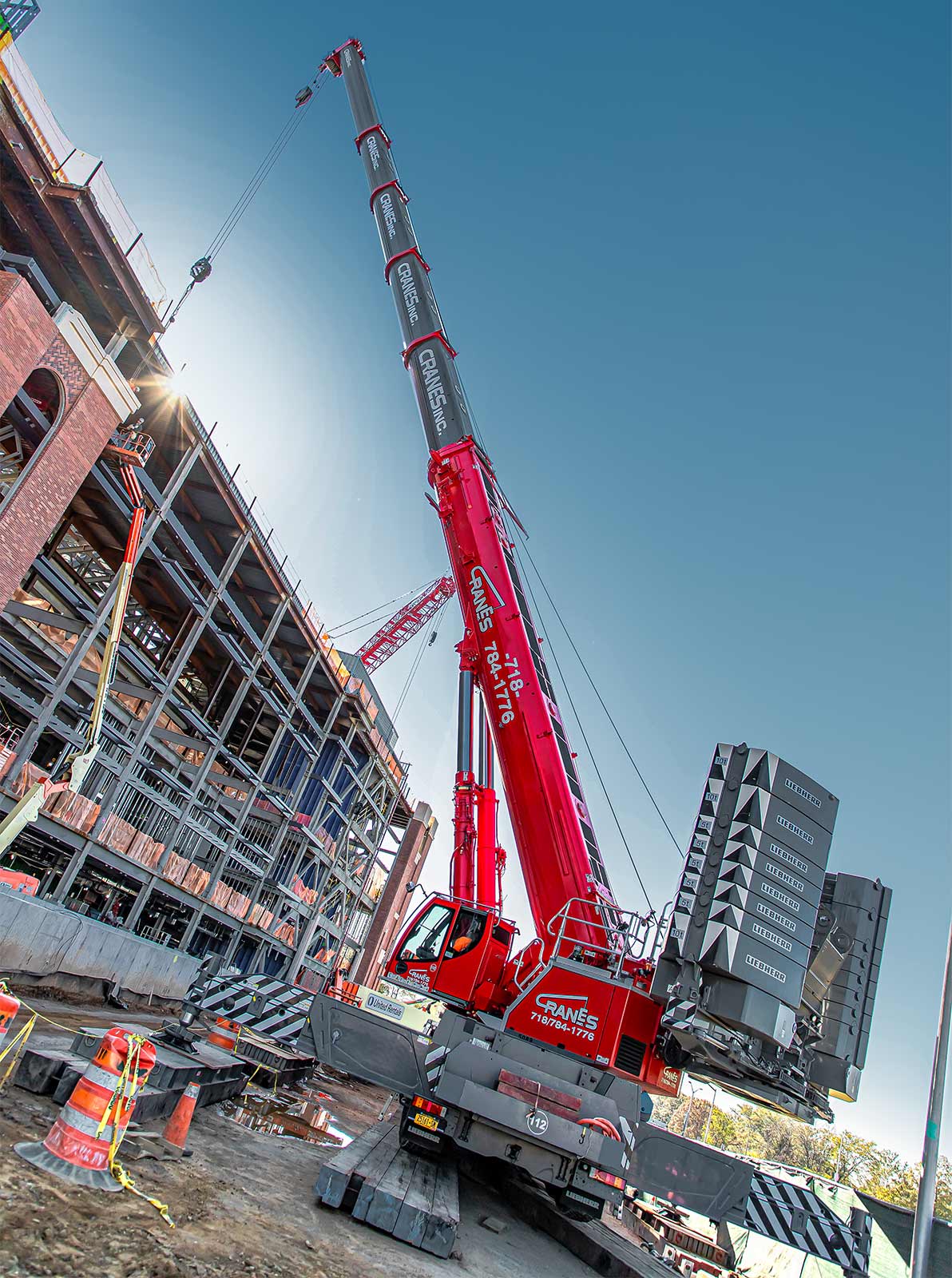
At the time of writing, one LTM 1450-8.1 is completing the rebirth of LaGuardia Airport while another one is operating at the future home of the New York Islanders hockey team – just to name two examples. “It’s really quite incredible how versatile this machine is,” Weiss explains. “Our LTM 1230-5.1s and LTM 1250-5.1s are also perfect complements to each other and help us better serve varying aspects of the New York market. While both machines have the same overall dimensions, the LTM 1230-5.1’s long boom makes it ideal for rigging work at height, while the other crane’s shorter but stronger boom makes that the perfect choice for heavy highway and civil construction. And with multiple outrigger and counterweight positions, both cranes can fit easily into constricted job sites.”
Demand led to U.S. Crane and Rigging confirming orders for seven additional all-terrains, rough-terrain and crawler cranes at March’s ConExpo in Las Vegas. “Our footprint is expanding rapidly,” says Petrosa. “We have three depots for cranes in the Bronx and Kingston, New York and Fort Lauderdale, Florida. We’re working in a 300-mile circle from the centre of the city.” As space is at a premium in the narrow confines of New York City and its surroundings, the compactness of the cranes is one of the most important buying criteria for our customers working in the city. Therefore Cranes Inc.’s most recently acquired cranes are 110 t (125 US-t) LTM 1110-5.1 and a 500 t (550 US-t) LR 1500. The LTM 1110-5.1s are actually part of a four-crane order of this model, all of which will arrive by next summer. Weiss admits, “I’ve long admired Liebherr’s single engine concept and how Ehingen’s engineers utilise the weight saved by eliminating the upper engine to reinforce key load bearing elements, thus, generating models that offer superior lifting capacities within their class.”
They truly care about their customers’ needs, and they always look to put the most reliable and technologically advanced cranes into the marketplace. I couldn’t think of a better partner.
Weiss remembers earlier visits to ConExpo – and his first Liebherr. He narrates, “We are a third-generation family business, and my father and I attended ConExpo together regularly over the years. In 1996, we saw something at the Liebherr stand that, quite frankly, knocked our socks off. It was the all-new LTM 1160/2, which offered a then unheard 60 m (197 ft) of telescopic boom plus swing away jib. As we stood there admiring the crane in the Las Vegas desert, all we could think about was how such a machine would revolutionise the crane business in the vertical world of New York, where reaching great heights is a must. We signed on the dotted line right then and there, and soon took delivery.”
Today, all of Cranes Inc.’s ATs and crawlers are 100% Liebherr, and it has ventured into the RT segment with 90 t (100 US-t) LRT 1090-2.1s. Weiss says, “It is both the people and the product that make Liebherr special. In all my years in the industry, I’ve never met a more dedicated group of professionals. They truly care about their customers’ needs, and they always look to put the most reliable and technologically advanced cranes into the marketplace. I couldn’t think of a better partner.”
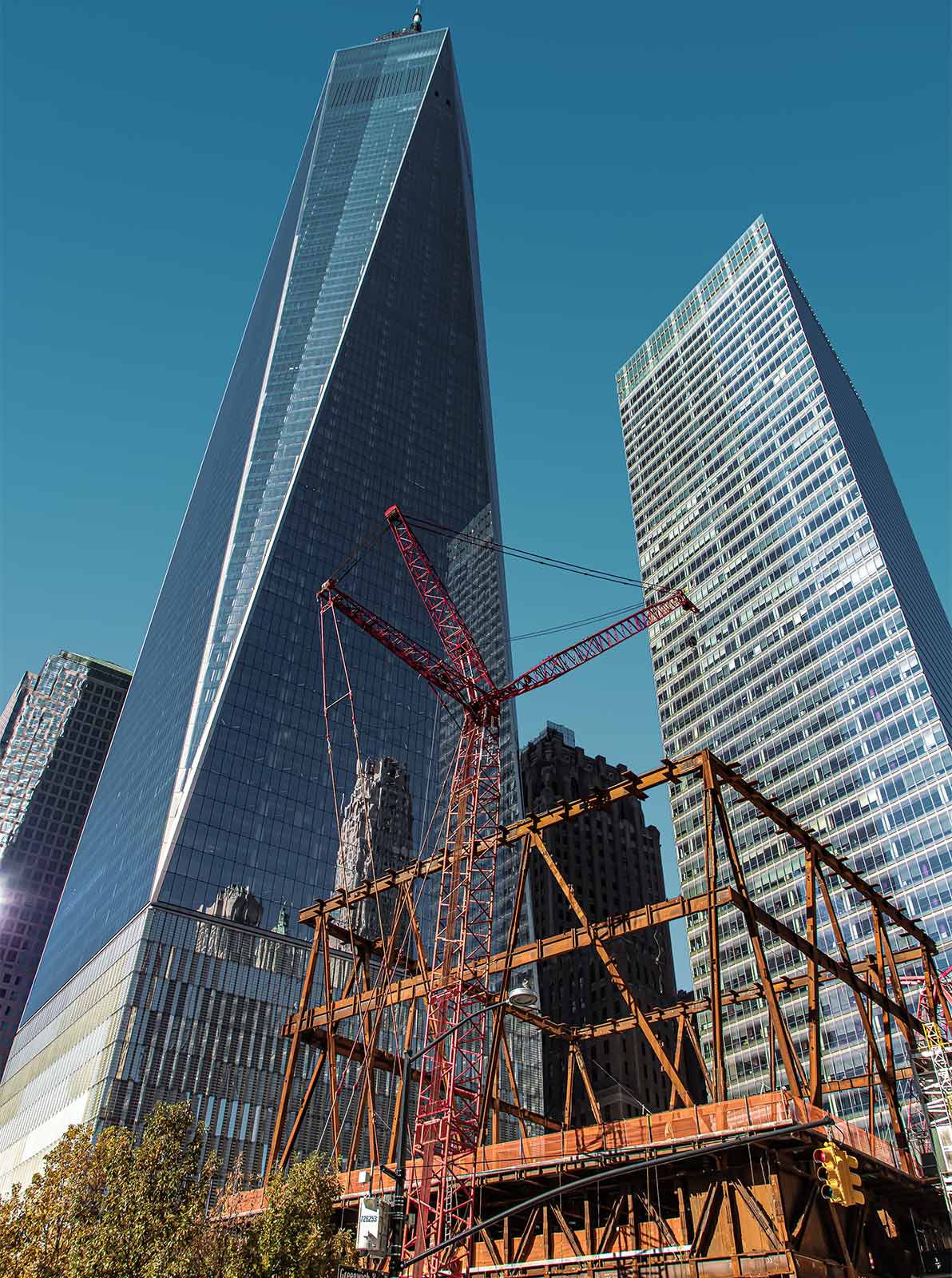
One of the reasons why New York is such a unique crane hotbed is that The Department of Buildings’ Cranes & Derricks Unit (known better as C&D) closely oversees the design, installation, and safe operation of equipment used for hoisting or lifting purposes. The department more widely promotes the safety of all people that build, work, and live in New York City by regulating the lawful use of over one million buildings and construction sites. It requires that all cranes used for construction be engineered by a third-party professional engineering firm and that operating permits be obtained for use. In addition, the agency performs annual and onsite inspections of cranes and even prototypes all new models entering the city. The C&D also mandates that cranes used for rigging work on the outside of existing buildings be supervised by a NYC-licensed Master Rigger.
The Department of Environmental Protection, meanwhile, has specific noise and emissions regulations that must be adhered to. Further, anything larger than the LTM 1110-5.1 requires a daily travel permit from the Department of Transportation, which must be ordered 48 hours in advance and includes specific route information and surveys. This list goes on and on. Navigating this complex web requires extensive local expertise and knowledge of the system and that is something that our customers, the crane rental companies in New York, are very specialised in. And this is necessary to stay on top of this uneasy game of operating in this non-stop city.
“It’s not easy to break into this market; we’ve been here since 1983 and the regulations are immense,” says U.S. Crane and Rigging’s Petrosa. “Our founder Thomas Auringer started the company nearly four decades ago. For Tom to get a non-union crane working in the city almost took fisticuffs — he fought for it.”
He continues, “What we’ve done in the last couple of years is streamline that process and taken us from a ‘man and a machine’ to ‘machines and a company’. Last year was our best year yet in New York City.”
The focus is on making what exists better and safer
And the market is expected to grow in the coming years. The opportunities in and around New York are endless. This city is a city that does not have a large footprint, so the only available space is to build up. The government is ever changing the land use laws to allow for higher construction. “The projects coming down the pipeline are emphasizing both infrastructure as well as air filtration and temperature improvements. The focus is on making what exists better and safer.” states JK cranes’ Jennifer Gabel. So growing is possible, even in such a complicated surrounding.
“We love the action and the streets of New York,” beams Petrosa. “We operate cranes, rig cranes, erect cranes… I perform license tests for operators, and we employ our own safety director who leads our training content and gives toolbox talks. That person visits every site at least twice a week. It’s a city that never sleeps - and neither do we.” Nor does any other New York crane rental company. The customer based in and around the city is as varied as the city itself.
While riggers form a large core of the business, so do also major civil contractors. In fact, the last few years saw the construction of many new bridges in the New York area, and numerous crawler and hydraulic cranes have been supplied for these huge and important projects. “On the complete opposite end of the spectrum, we are currently renting an LTM 1230-5.1 to a landscaping firm that is using the crane to set trees along the West Side Highway in Manhattan - and we have annually provided some LTC 1050-3.1 to help assemble floats for the Macy’s Thanksgiving Day Parade. You never know who is going to call - and that is what makes working in New York so exciting,” Weiss adds.
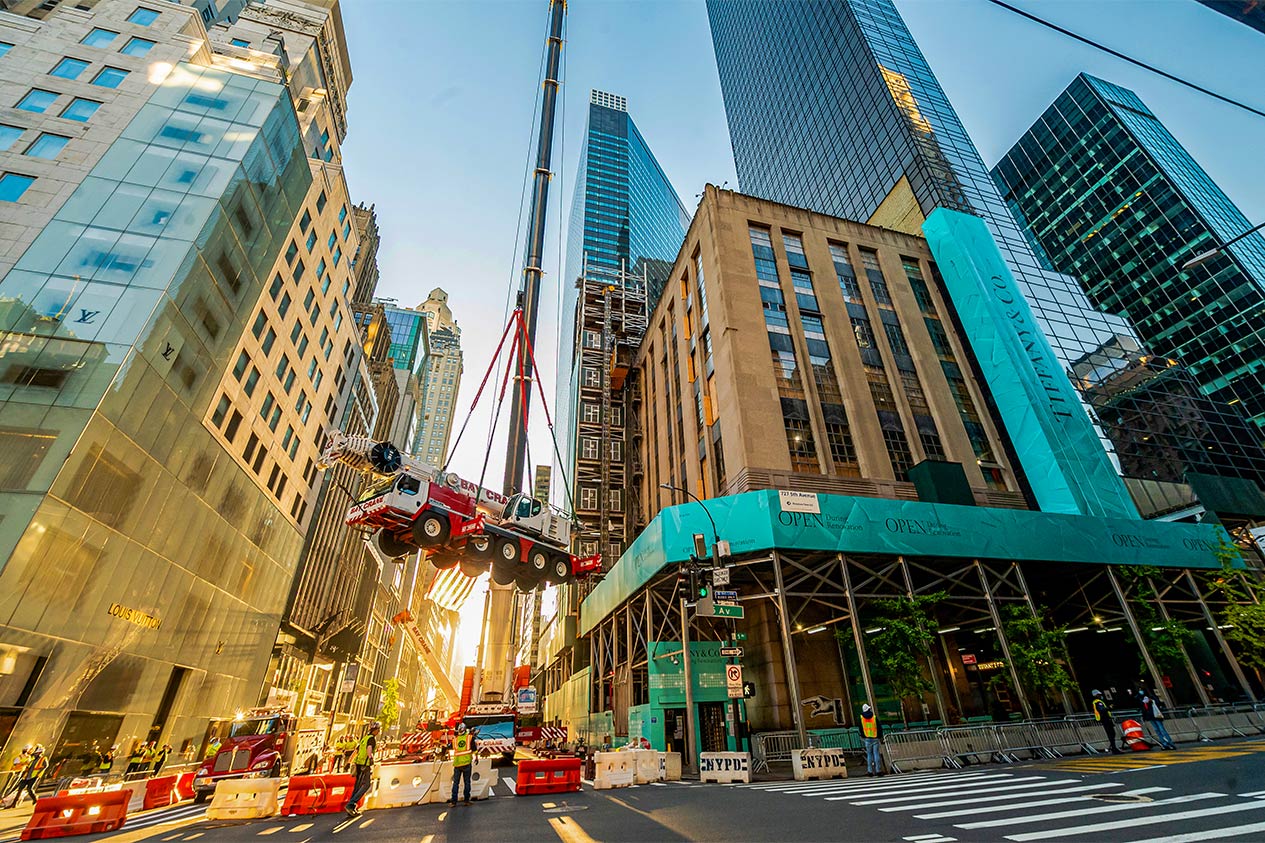
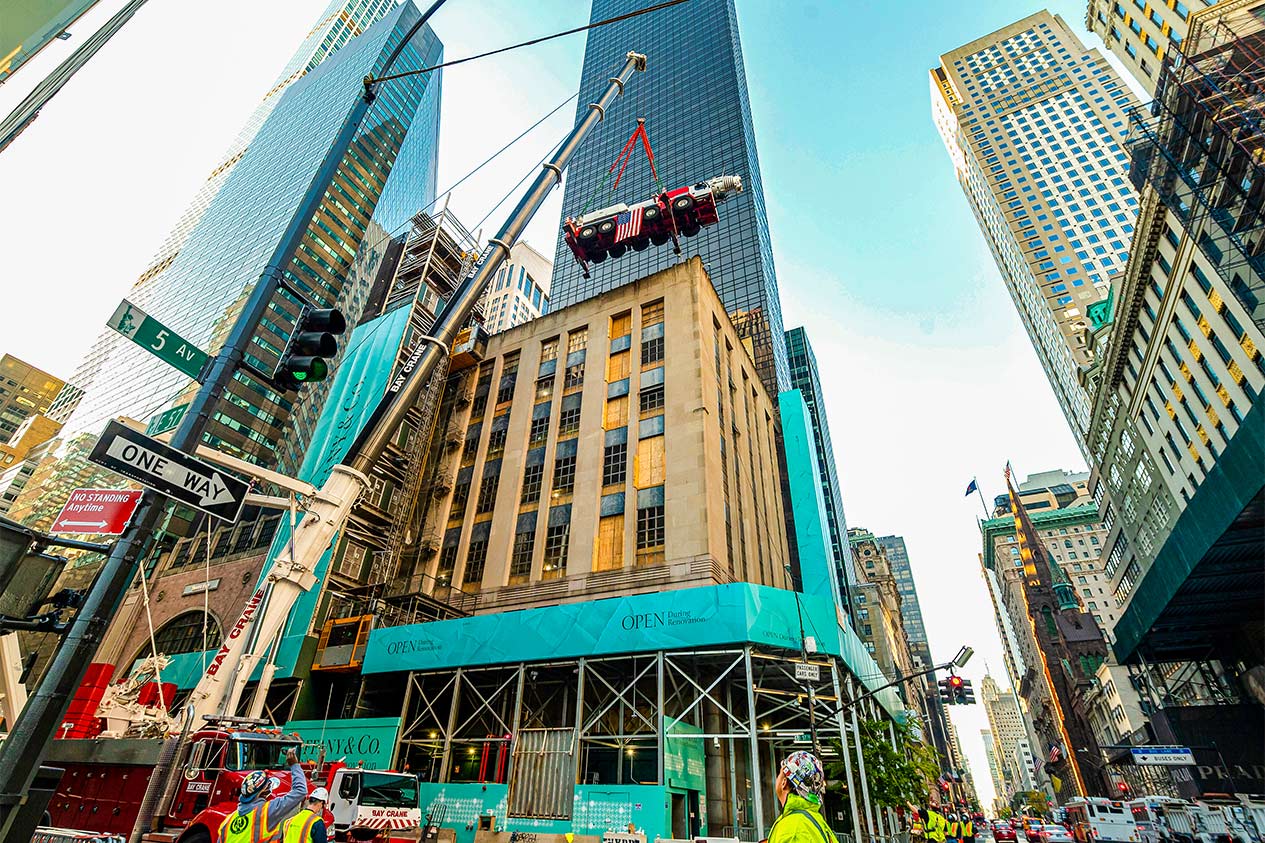
Exciting work can also make history. A couple of weeks ago, Bay Crane was called for an untypical task in Manhattan. As part of the construction process to continue the transformation of the Tiffany & Co. New York flagship on Fifth Avenue, a mobile crane had to leave the ground to reach the necessary height. This is only the fourth time in the construction history of New York City that a crane has lifted a crane onto the roof of a building.
The LTM 1130-5.1 mobile crane is in use to continue transformation of the Tiffany & Co. flagship store. It will help to build the reimagined upper addition (floors 8, 9, and 10) of the 10-story building from office space into an exhibition and event location.
A giant LTM 1500-8.1 from Bay Crane, assembled with Y-guying system, lifted the small 5-axle mobile crane with its weight of 60 t (66 US-t) seven storeys over 57th Street and Fifth Avenue.
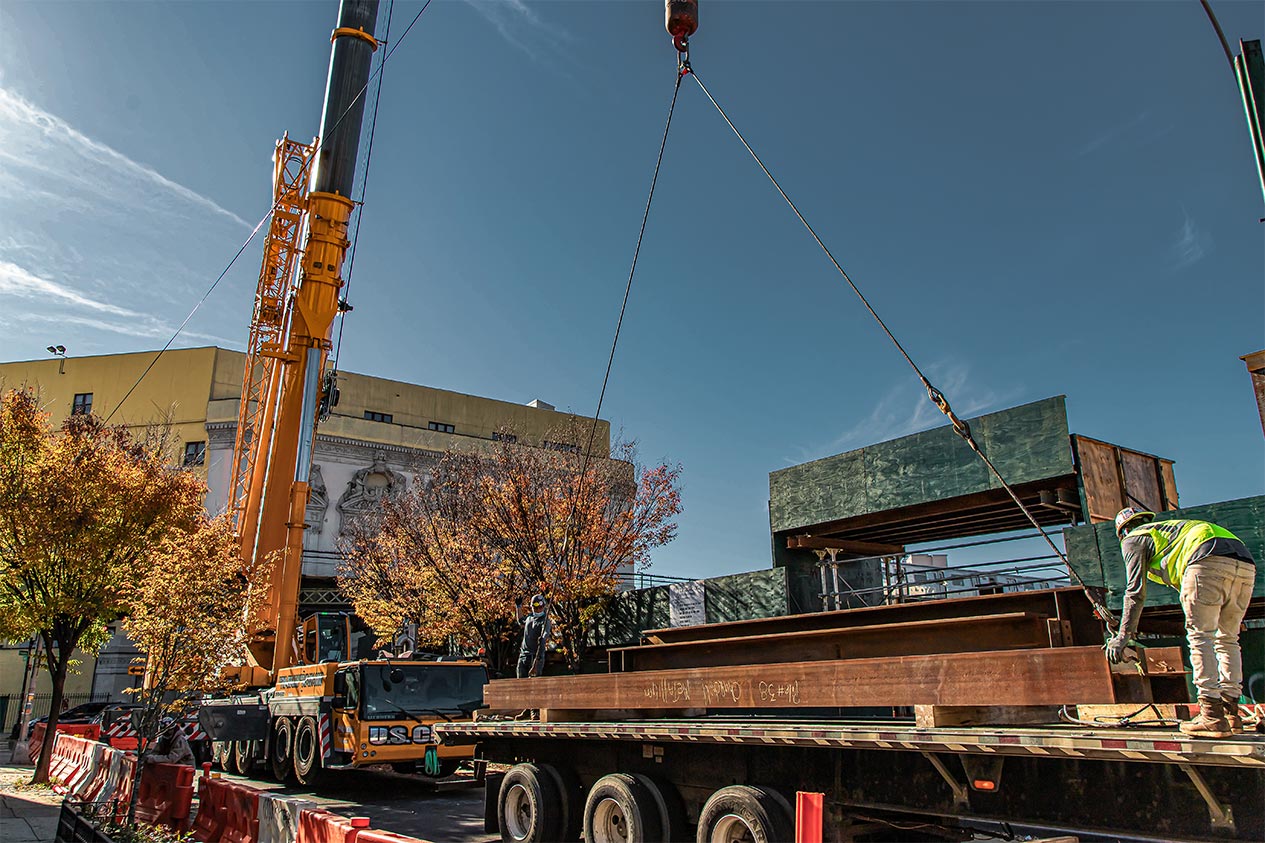
U.S. Crane and Rigging sent a LTM 1300-6.2 to Erik Ekstein’s latest development in Bushwick, Brooklyn. The property is located on the corner of Broadway and Palmetto Street. Dan Mooney, sales manager at U.S. Crane and Rigging, explained that the crane has both the capacity and the reach to maximise productivity during plank installation, an important phase of the construction process. The development will comprise 31,510 m2 (103,378 sq. ft.) of residential, commercial area and community buildings. The anticipated date of completion is spring 2021.
Meanwhile Cranes Inc. is playing a central role in creating a future home for the New York Islanders hockey team at the new Belmont Park Arena. The customer is A.J. McNulty & Co. Inc., a local structural steel and precast concrete erector.
It has supplied numerous cranes to the contractor erecting the precast concrete façade, from a LTM 1250-5.1 up to the company’s brand new LR 1500. Assembled in mid-September, it is operating from a 3.6 m (12 ft.) thick hardstand of gravel, on top of which are two layers of hardwood mats. All of this is required in order to reduce ground-bearing pressures. Cranes Inc. is handling large and very ornate architectural panels, all of which must be set with the utmost care. In a sense, this is the work of artisans, as the crews must have a smooth touch.
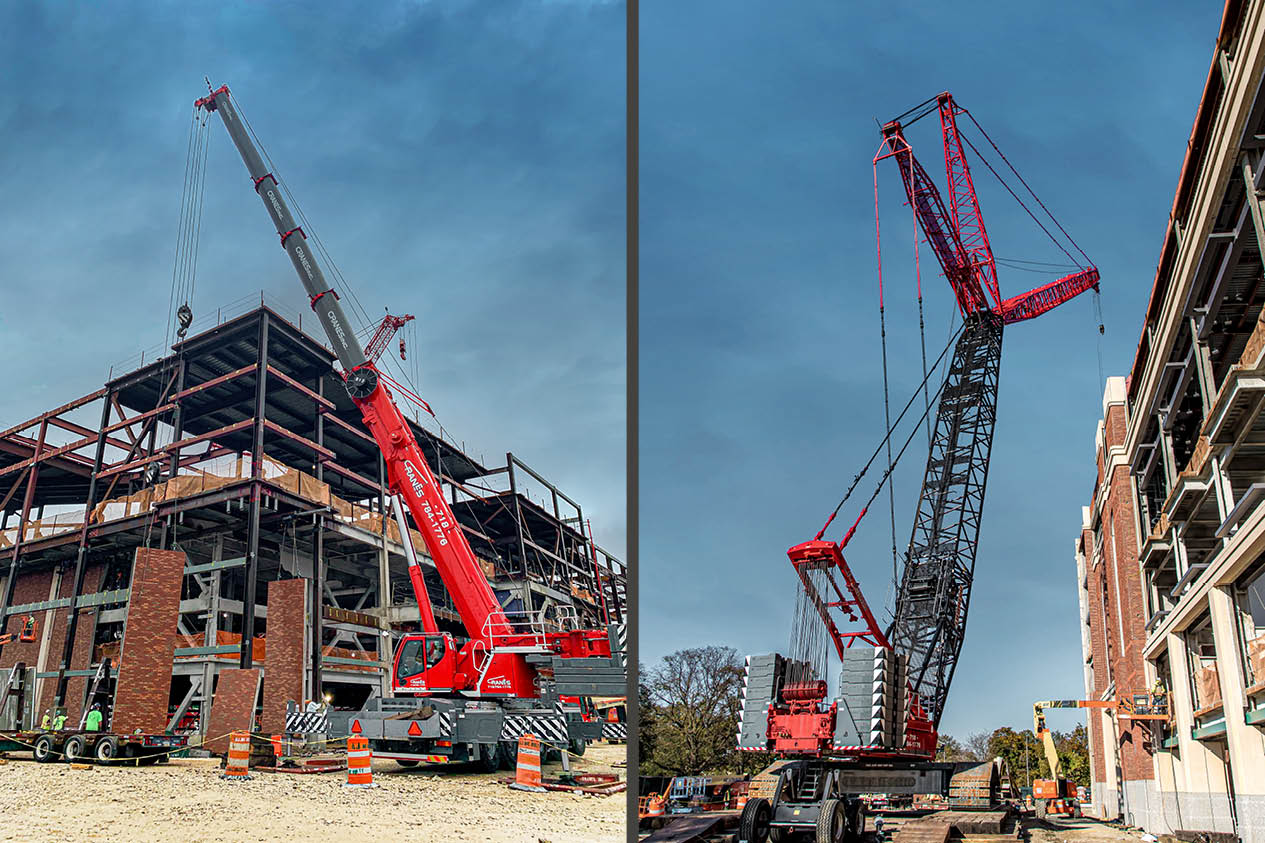
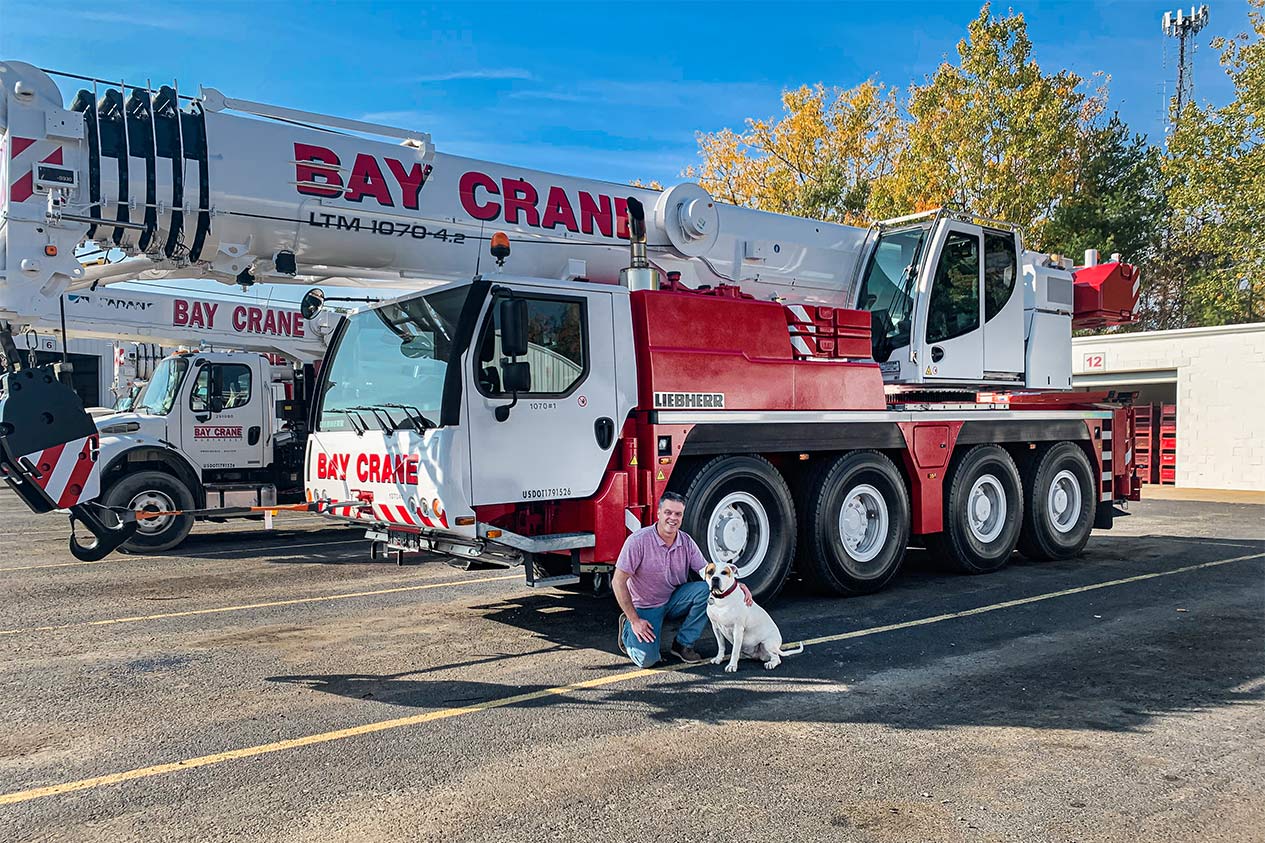
Call, “Liebherr!” in Rhode Island, to the northeast of New York, and it will not only be a mobile crane that appears on the horizon. Liebherr the dog, owned by Bay Crane branch manager Josh Wilbur, will come running. Liebherr has been owned by Wilbur almost exactly two years at the time of writing, after a chance encounter at a rescue centre.
“I was in search of a new dog,” Wilbur recalls. “My family had a dog but I wanted a more active companion that I could take with me every day. On a chance, I visited a local animal shelter and two dreams come true. When I saw her, I felt the bond instantly. Liebherr had not been there long. The caretakers of the shelter said she was a sweet dog and they were right. When she arrived home, Liebherr was reluctant to leave the car, but after some training and much love, she realised she was in a good home.”
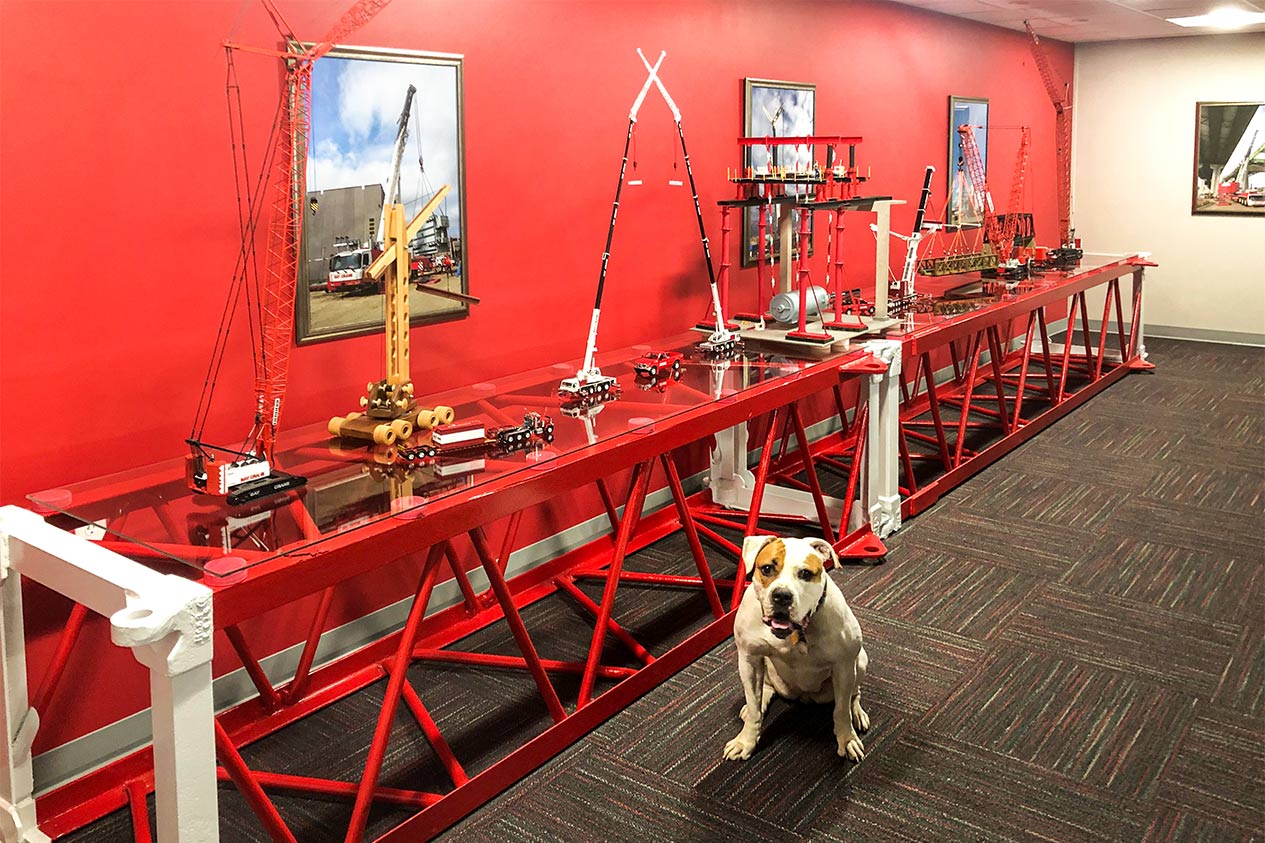
He continues, “I chose the name Liebherr because I had hopes that she would be a dependable, reliable and hardworking dog—just like a Liebherr crane. I can always count on these cranes to perform consistently and well and, so far, my dog hasn’t let me down either.” Liebherr’s (the dog) second home is Bay Crane Northeast, based in Smithfield. She goes to work every day with Wilbur and enjoys her time in the office and in the yard. She is often seen running around, hopping in various vehicles, and has even been caught pulling some of the rigging gear. “Her favourite place is the lunchroom, where she gets lots of treats,” says Wilbur. “Liebherr and I are very lucky to have met each other.”
This article was published in the UpLoad magazine 01 | 2021.